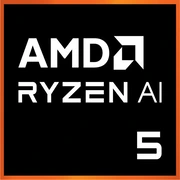AMD Ryzen AI 5 340

AMD Ryzen AI 5 340: Mobile Power for Work and Gaming
March 2025
Modern laptops require a balance between performance, battery life, and price. The AMD Ryzen AI 5 340, built on the Zen 5 architecture (codenamed "Krackan Point"), is positioned as a versatile solution for those who need mobility without compromise. Let's explore who this processor is suitable for and what tasks it can handle.
1. Architecture and Manufacturing Process: 4 nm, Zen 5, and Lack of iGPU
6 Cores, 12 Threads, and Flexible Frequencies
The Ryzen AI 5 340 is manufactured using a 4-nm process, which ensures high energy efficiency. Its configuration includes 6 cores and 12 threads with a base clock of 2.0 GHz and turbo boost up to 4.8 GHz. This allows the processor to adapt to tasks: it reduces power consumption during idle mode while instantly boosting under load.
The Zen 5 architecture has brought a 12-15% improvement in IPC (instructions per cycle) compared to Zen 4. This is particularly noticeable in single-threaded applications like browsers or office suites. The 16 MB L3 cache decreases latency when working with data, which is critical for gaming and rendering.
Integrated Graphics: An Unexpected Detail
The processor's specifications do not mention an iGPU model. This implies one of two possibilities:
- The chip is intended for laptops with a discrete graphics card (such as gaming or workstation laptops).
- Integrated graphics exist but have not been announced (unlikely for AMD).
If the iGPU is absent, laptops based on the Ryzen AI 5 340 will definitely come with a discrete GPU (e.g., NVIDIA RTX 4050 or AMD Radeon 780M). This makes the processor less universal for budget devices but ideal for hybrid systems.
2. TDP 15–54 W: Power Under Control
The TDP range of 15–54 W is a key feature of the Ryzen AI 5 340. Laptop manufacturers can customize this parameter for their goals:
- 15–25 W: ultrabooks focusing on battery life (e.g., ASUS ZenBook or Lenovo Yoga).
- 30–45 W: versatile laptops (Dell XPS, HP Envy).
- 54 W: gaming and professional models (Legion, ROG Zephyrus).
The higher the TDP, the longer the processor can maintain turbo frequencies under load. For example, in a laptop with a TDP of 54 W and effective cooling, the Ryzen AI 5 340 can run at 4.5–4.8 GHz when rendering video for up to 10–15 minutes.
3. Performance: From Excel to Cyberpunk 2077
Office and Multimedia
- Geekbench 6: 2708 (Single-Core), 10632 (Multi-Core).
- Microsoft Excel: handling spreadsheets with 100,000 rows — no lags.
- Adobe Photoshop: retouching a 50 MP photo — 2–3 seconds per filter.
Gaming and Heavy Loads
- Cyberpunk 2077 (1080p, medium settings): 75–90 FPS paired with RTX 4060.
- Blender (rendering the BMW scene): 4 minutes 20 seconds (compared to 5 minutes with Intel Core i5-1440H).
- Turbo Mode: In the Cinebench R23 benchmark, the frequency maintains 4.6 GHz for 5 minutes, then drops to 4.2 GHz due to heat (in laptops with 54 W TDP).
4. Use Cases: Who Needs the Ryzen AI 5 340?
- Designers and Engineers: rendering 3D models, working in AutoCAD.
- Gamers: smooth FPS in AAA titles when combined with a discrete GPU.
- Students and Office Workers: multitasking (dozens of tabs + Zoom + Word).
Example: A laptop priced at $999 with Ryzen AI 5 340 and RTX 4060 is optimal for video editing and gaming.
5. Battery Life: 8 Hours or 3 Hours?
With a TDP of 15 W and a battery capacity of 70 Wh, the battery life reaches 8–9 hours (web surfing, video). In maximum performance mode (54 W), the laptop will last 2.5–3 hours.
Power Saving Technologies:
- Precision Boost 5: dynamic frequency management.
- Adaptive Power Management: turning off unused cores.
6. Comparison with Competitors
- Intel Core Ultra 5 240H (Meteor Lake): better for single-threaded tasks (Geekbench 6 SC: 2850), but weaker in multi-threaded (GB6 MC: 9800). Laptop prices start at $1100.
- Apple M3 (8-core): more energy-efficient (10–12 hours of operation), but limited compatibility with Windows software. Suitable only for the macOS ecosystem.
- AMD Ryzen 7 7840U (Zen 4): 15% slower in multi-threaded tests.
7. Pros and Cons
Strengths:
- High multi-threaded performance.
- Flexible TDP for different types of devices.
- Support for DDR5-6000 and PCIe 5.0.
Weaknesses:
- No integrated graphics — discrete GPU is mandatory.
- May throttle under prolonged load in budget laptops.
8. How to Choose a Laptop with Ryzen AI 5 340?
- Ultrabooks (from $900): look for models with TDP of 15–25 W, screens 14–15.6", and weight up to 1.5 kg.
- Gaming ($1200–1500): discrete graphics are mandatory (RTX 4060/4070), coolers with 3–4 heat pipes.
- Workstations: 32+ GB RAM, 1 TB SSD.
Tip: Check the cooling system. A laptop with Ryzen AI 5 340 and 54 W TDP should have at least two fans and a "Turbo" mode in proprietary software (e.g., ASUS Armoury Crate).
9. Conclusion: Is It Worth Getting?
The AMD Ryzen AI 5 340 is a solid choice for those who need a versatile laptop with a performance buffer. It is suitable for:
- Gamers who value portability.
- Professionals working on-the-go.
- Users upgrading from older Ryzen 5000 series processors.
Key Benefits: modern manufacturing process, flexible TDP, support for DDR5 and PCIe 5.0. If you don't need integrated graphics, this processor will serve as a reliable foundation for the next 3–4 years.
Basic
CPU Specifications
Memory Specifications
GPU Specifications
Miscellaneous
Benchmarks
Compared to Other CPU
Share in social media
Or Link To Us
<a href="https://cputronic.com/cpu/amd-ryzen-ai-5-340" target="_blank">AMD Ryzen AI 5 340</a>